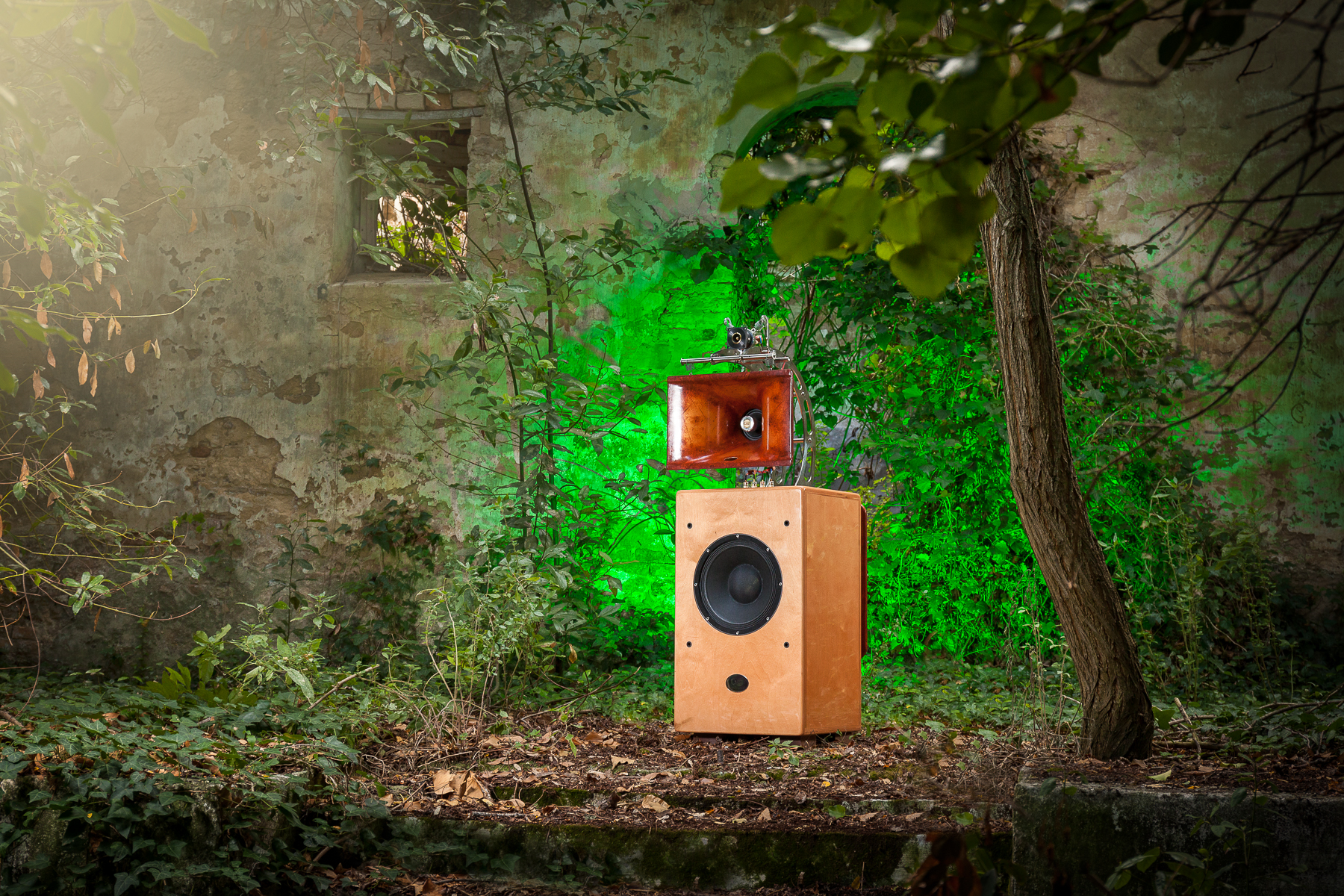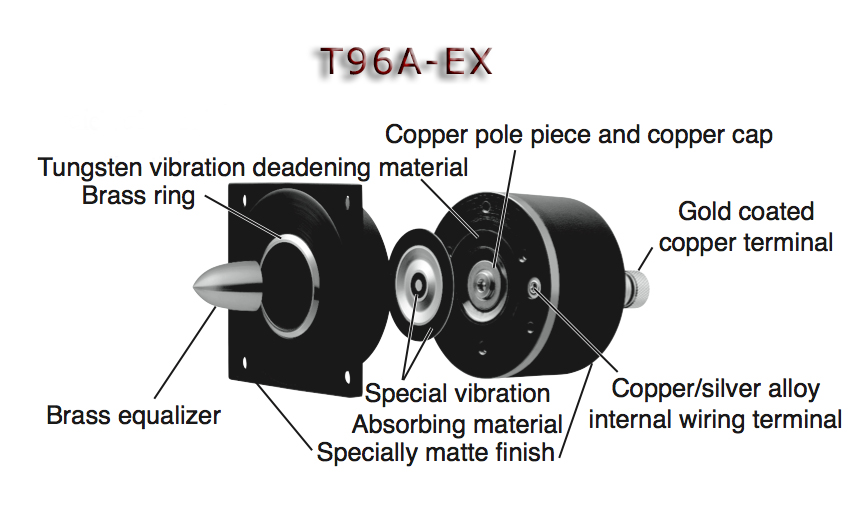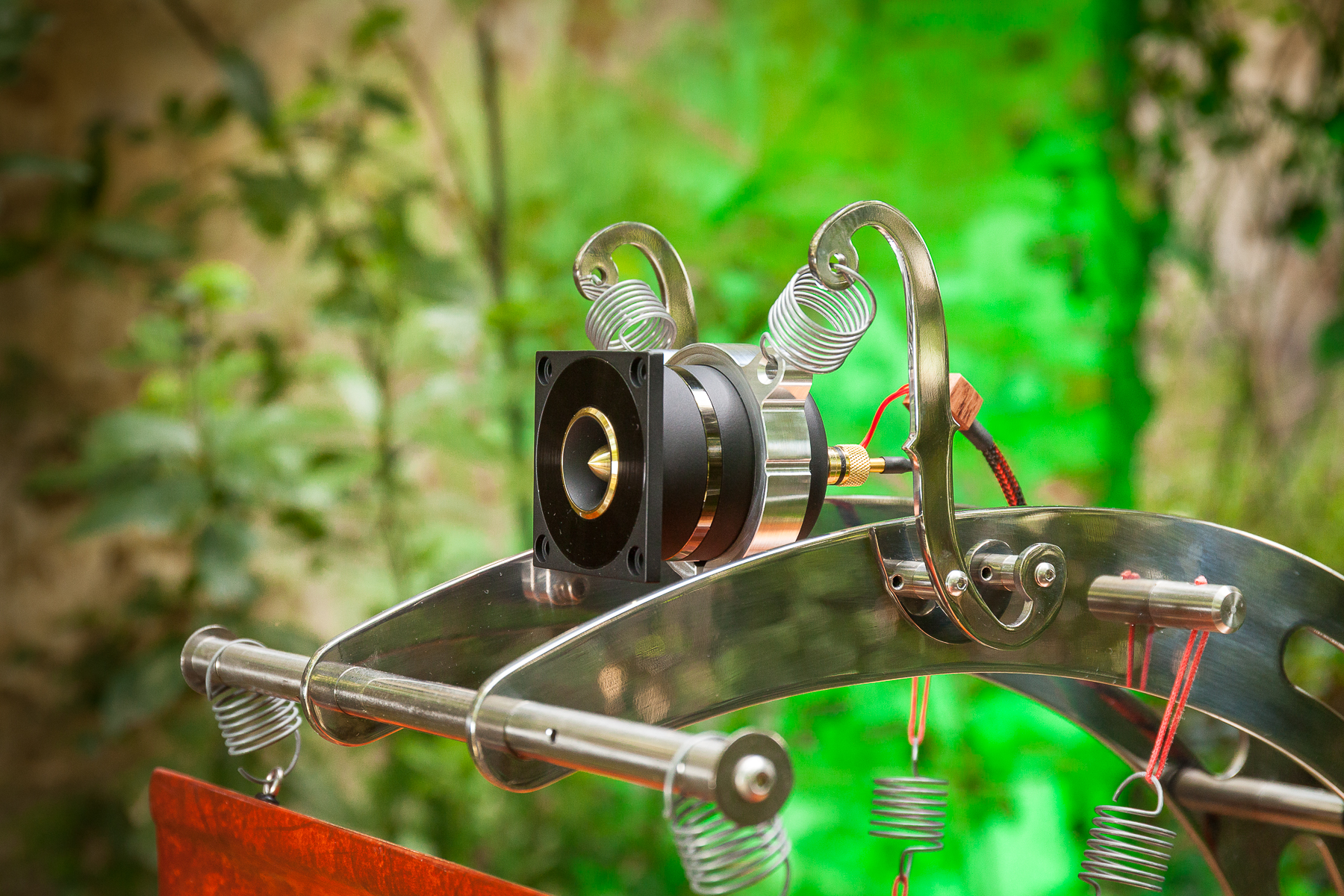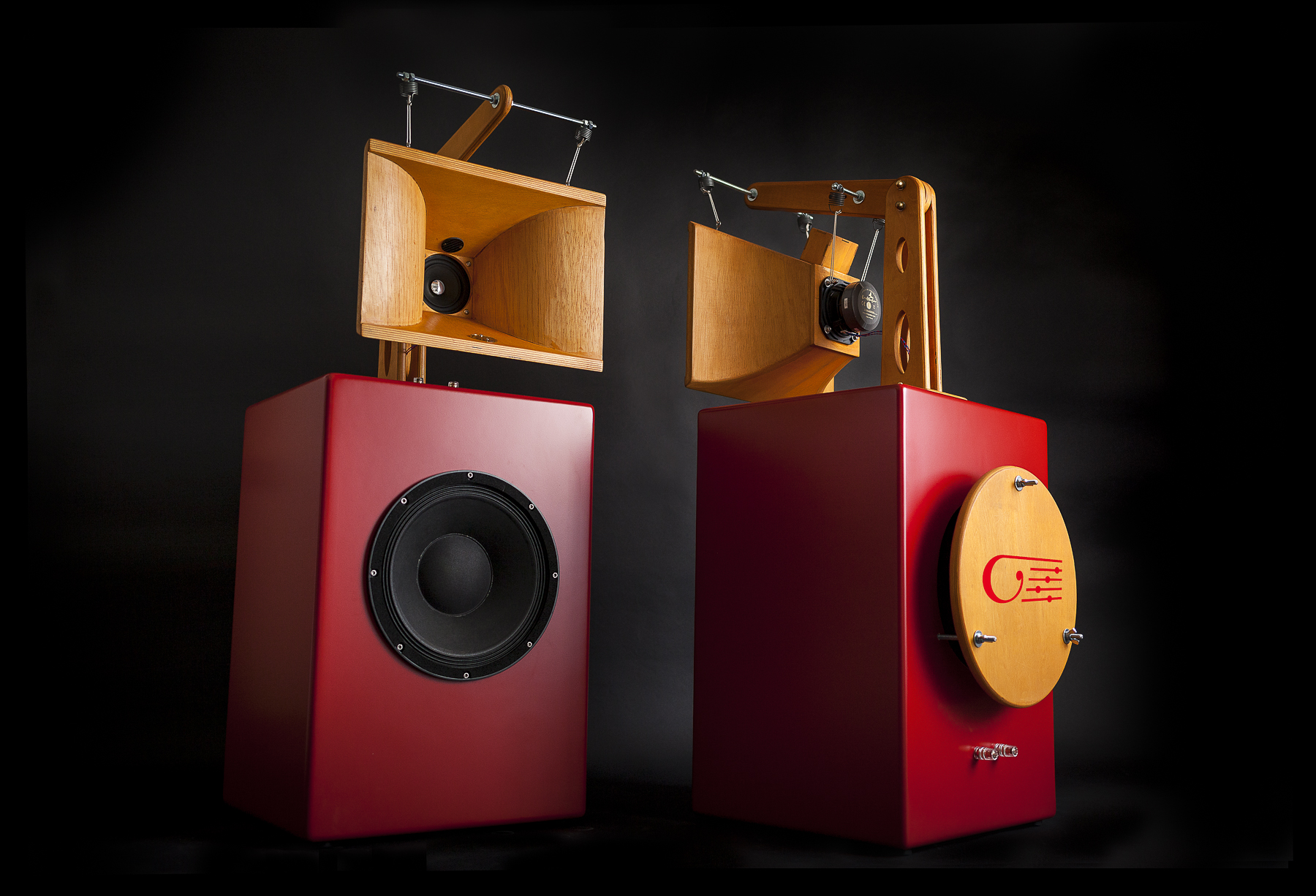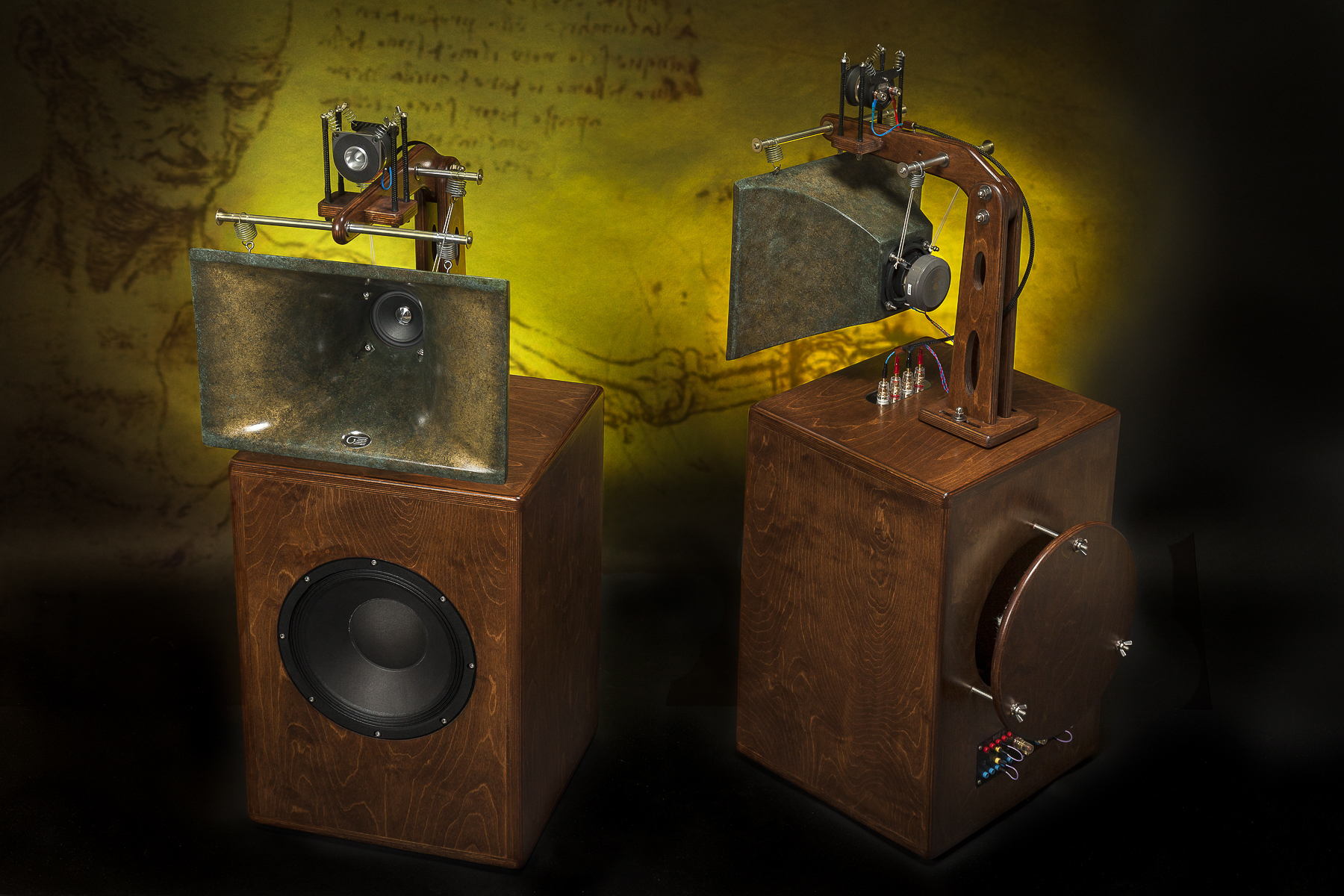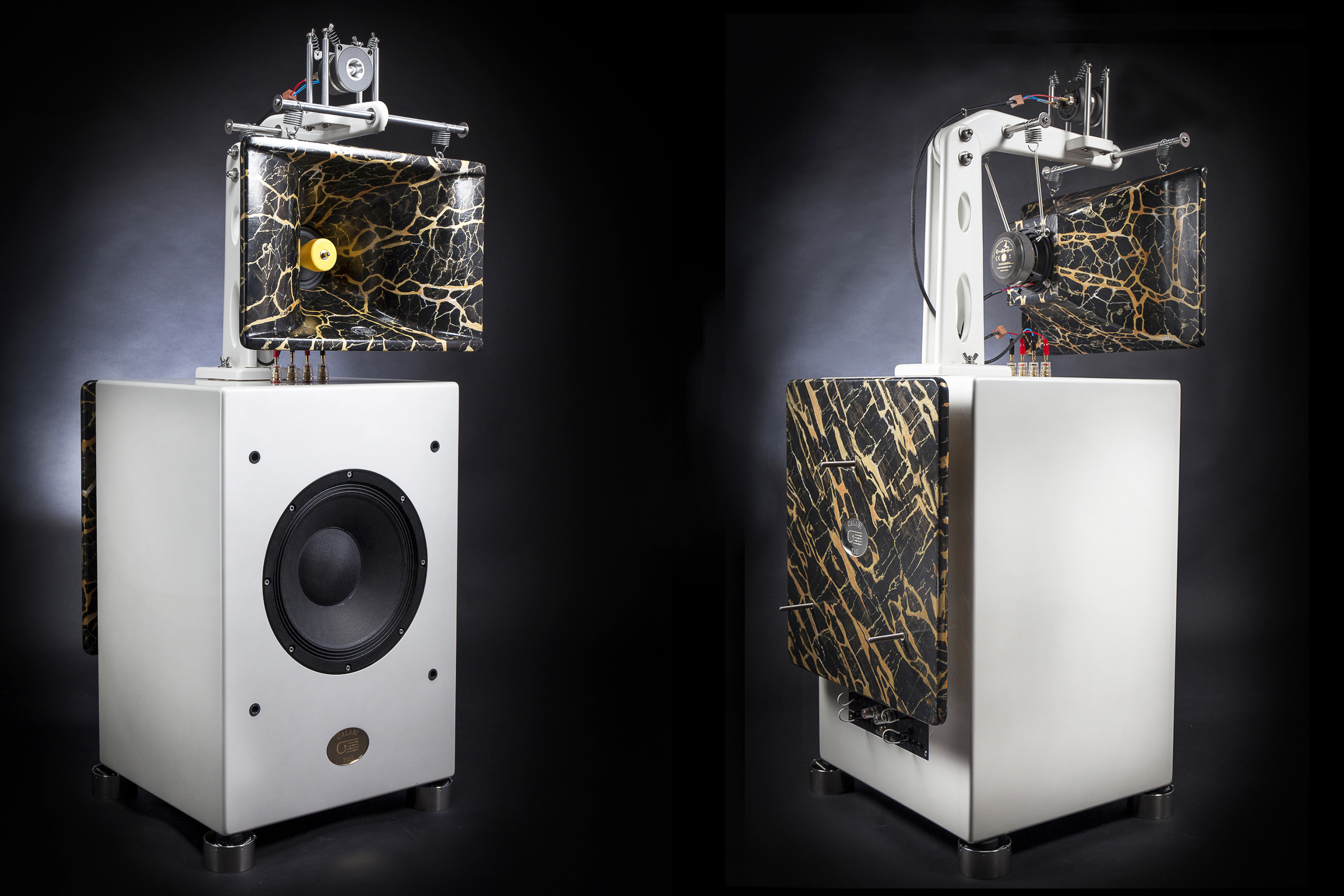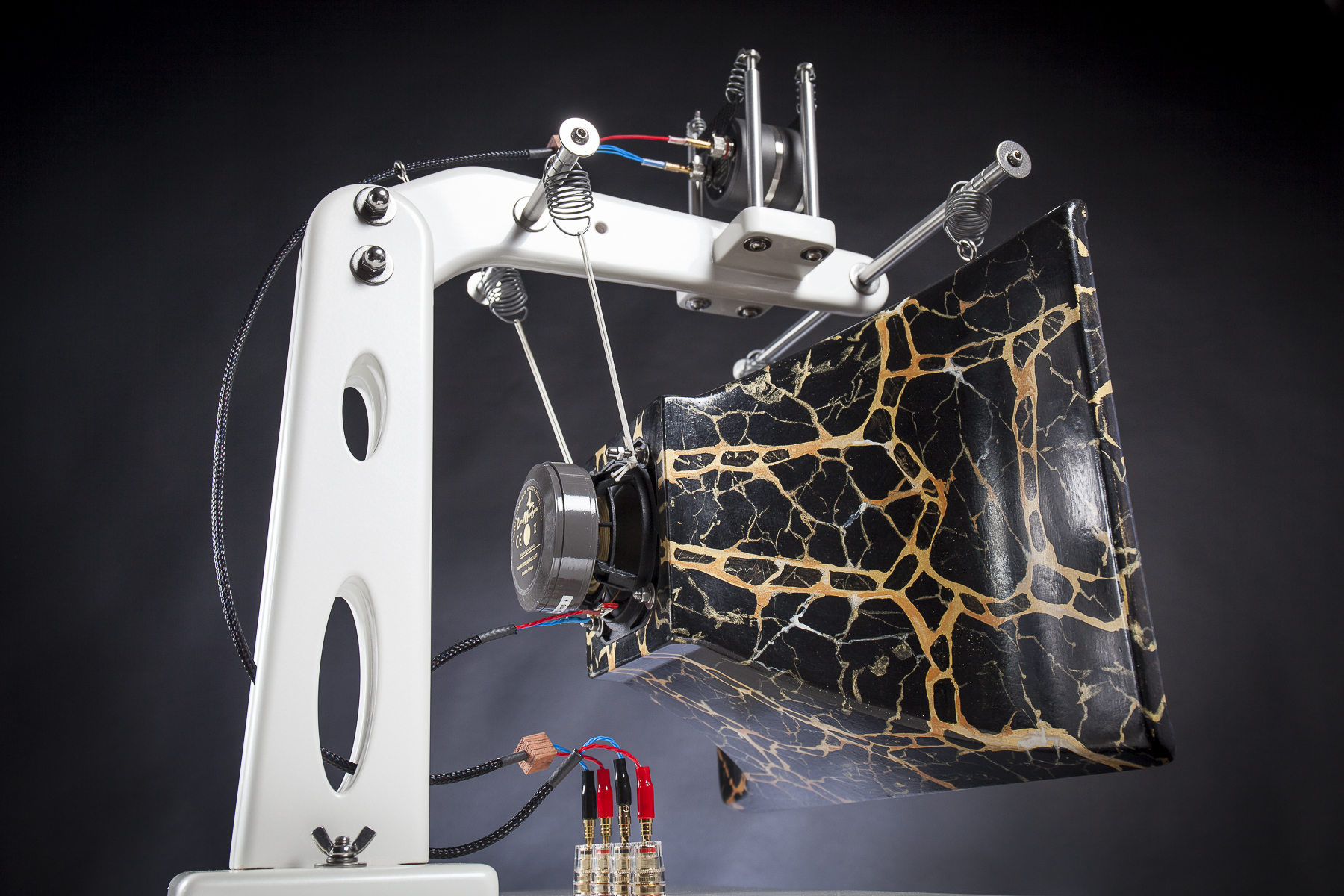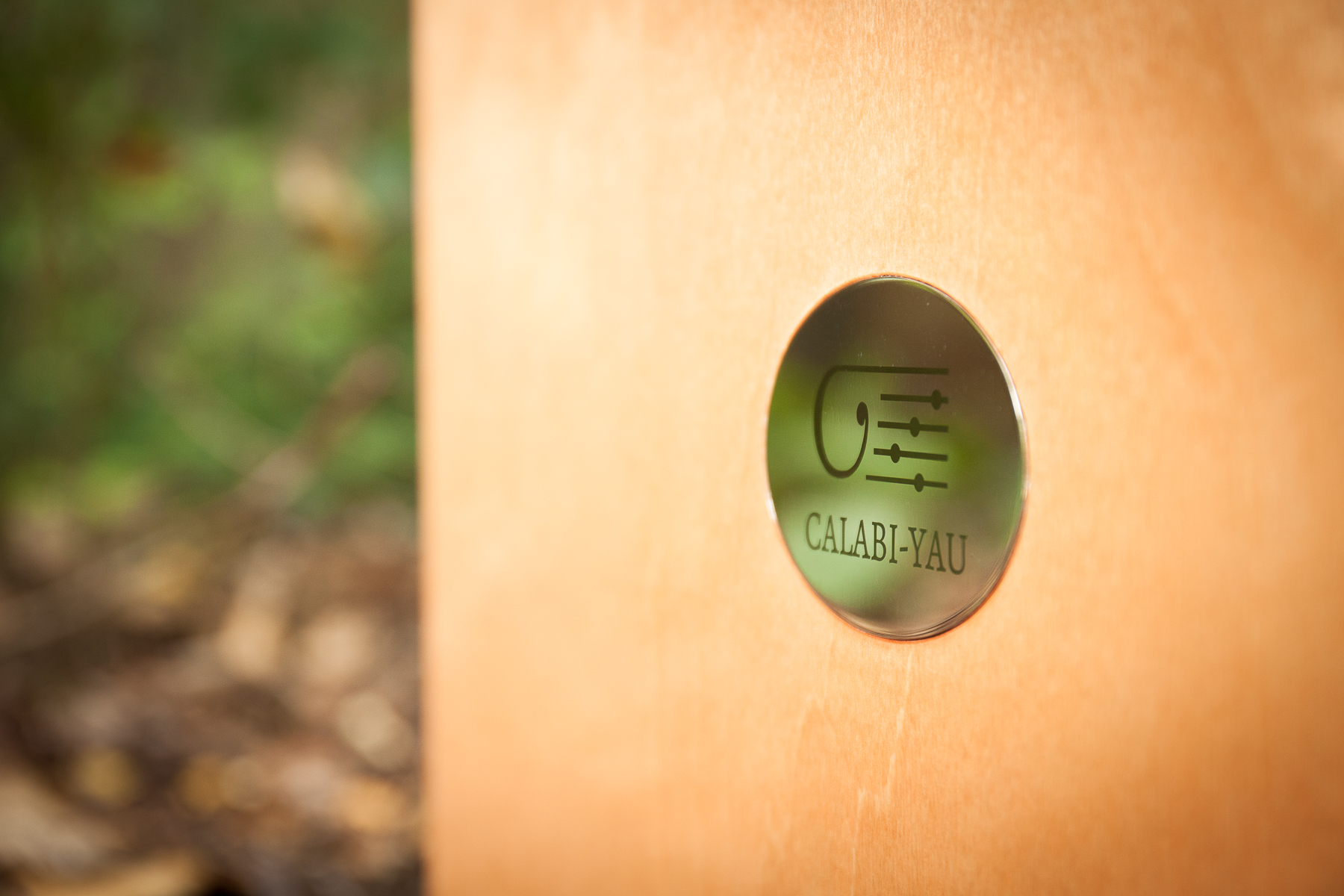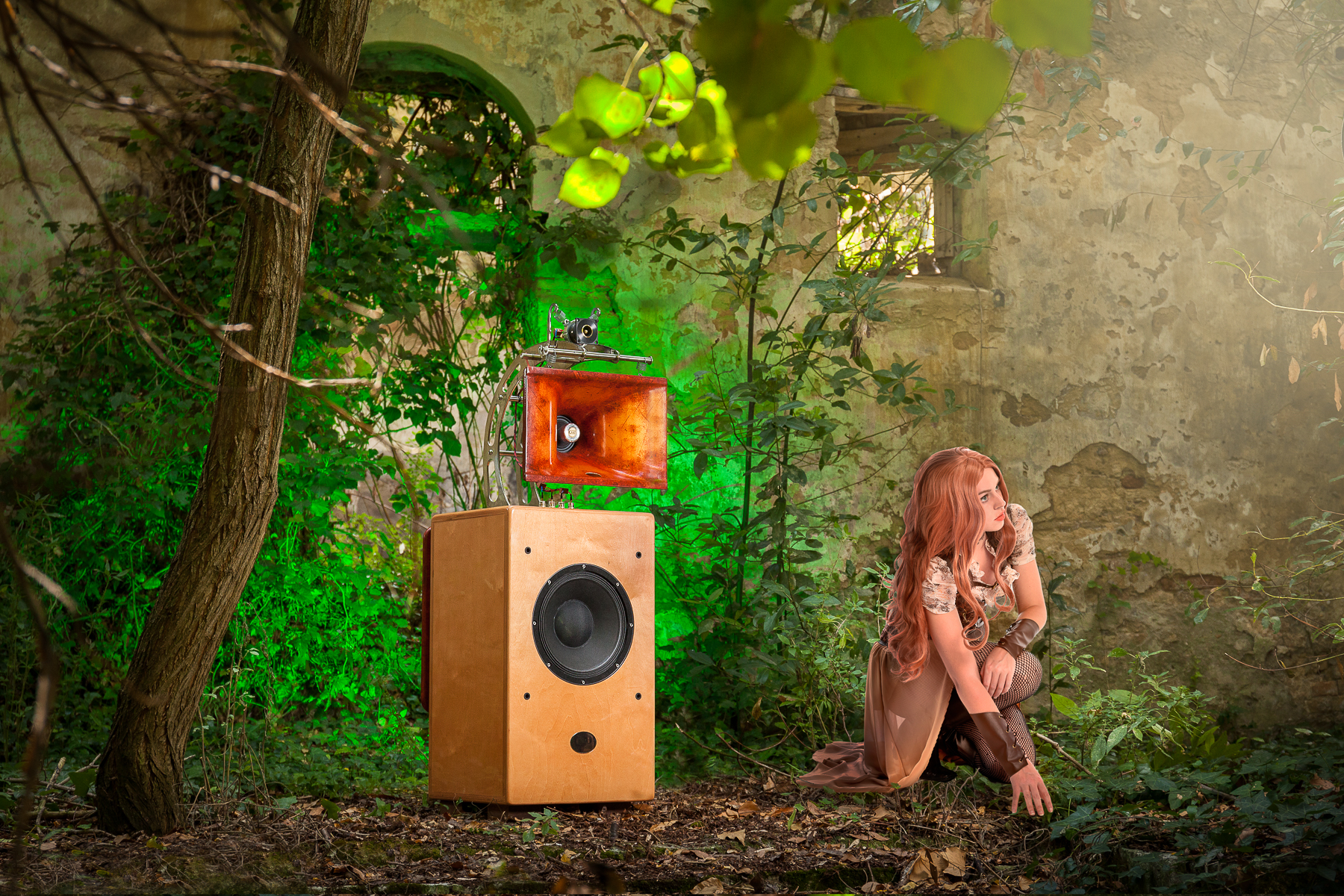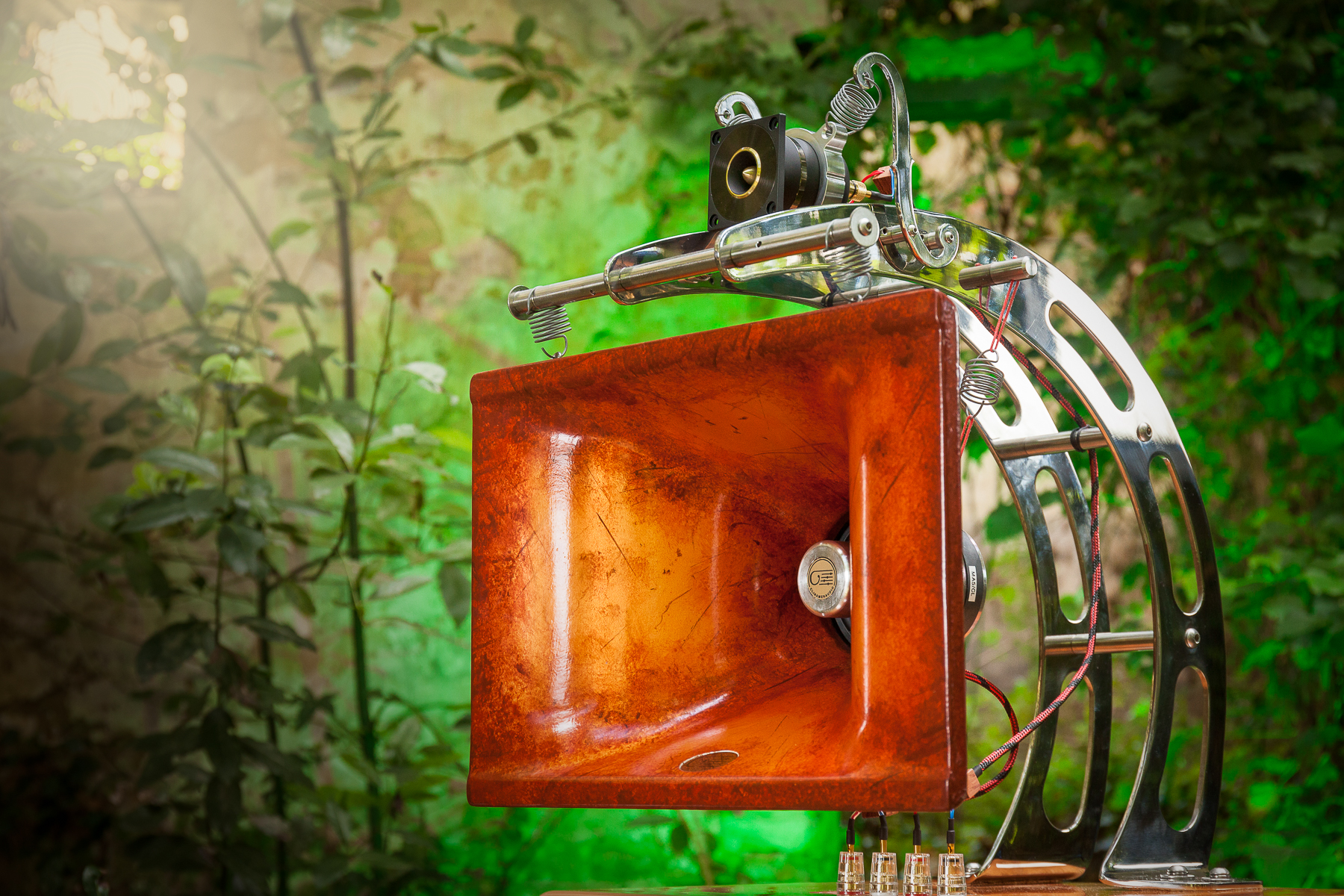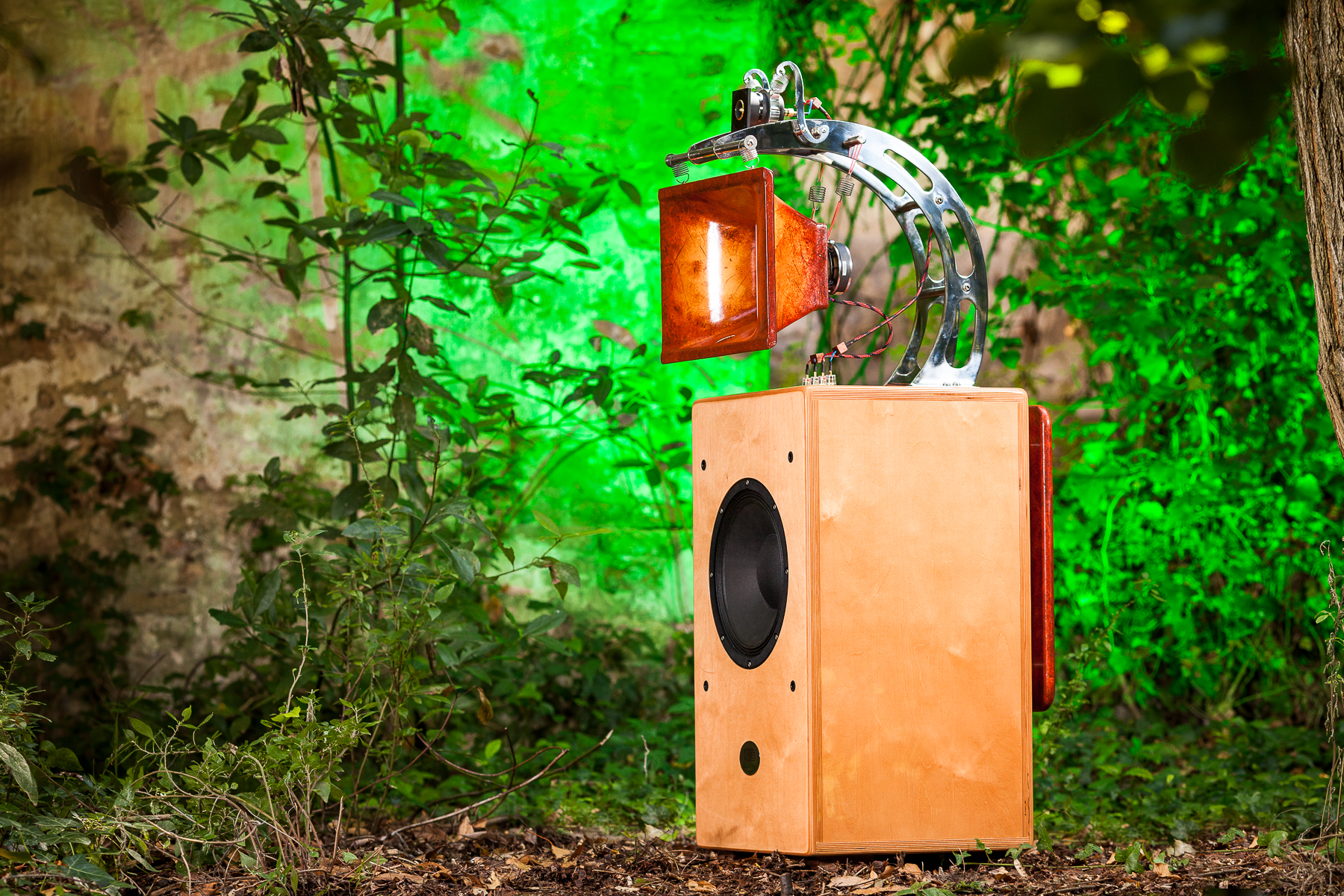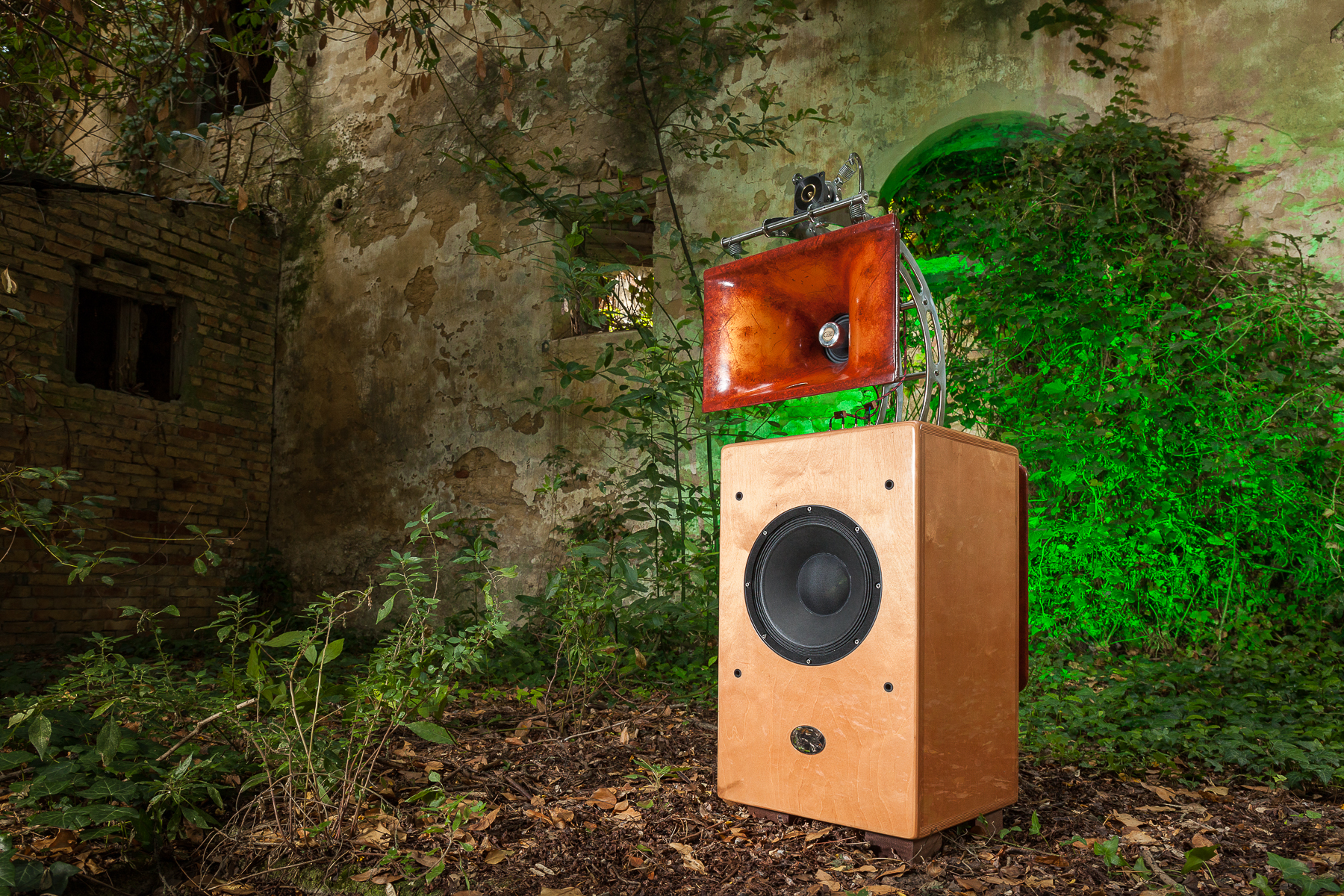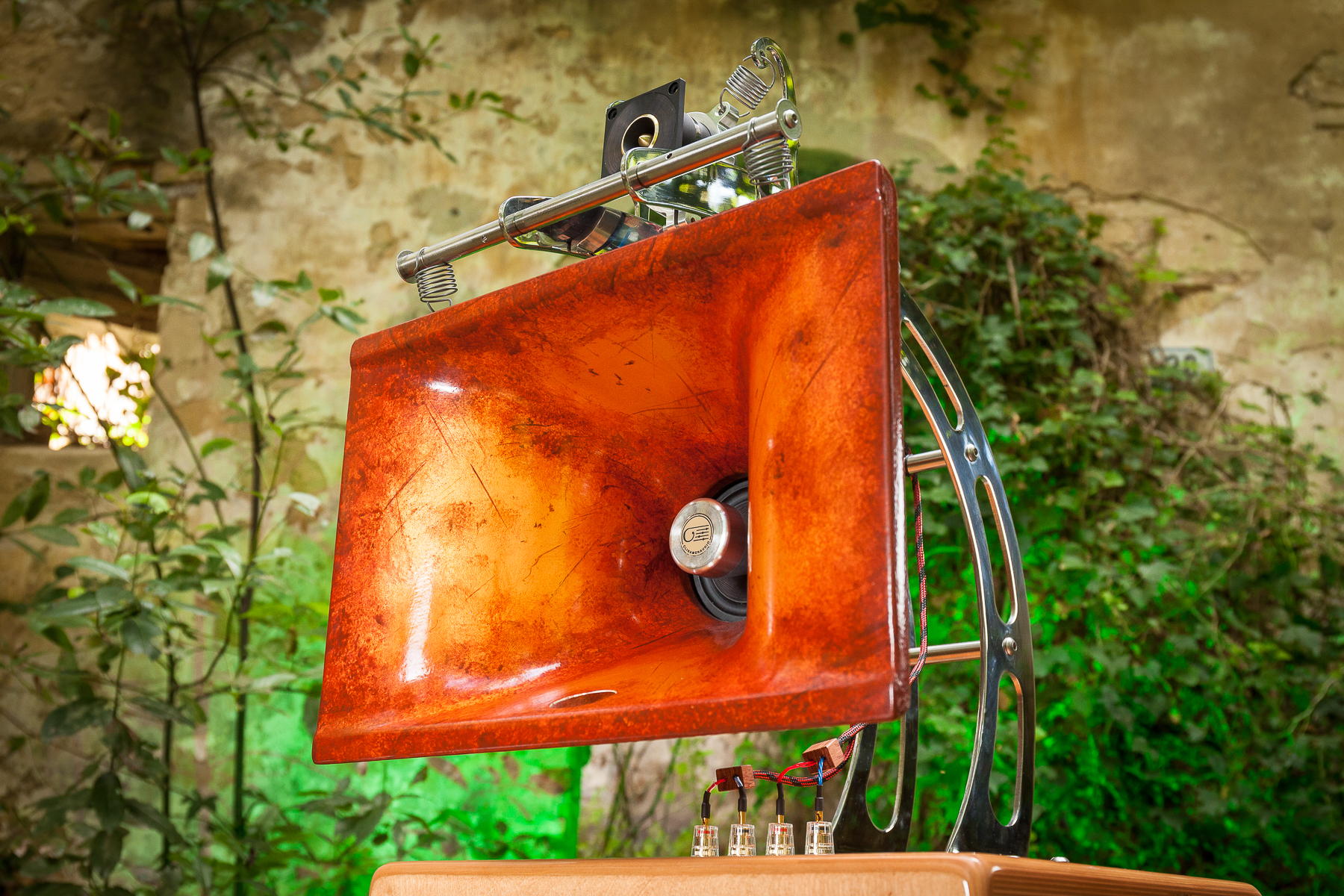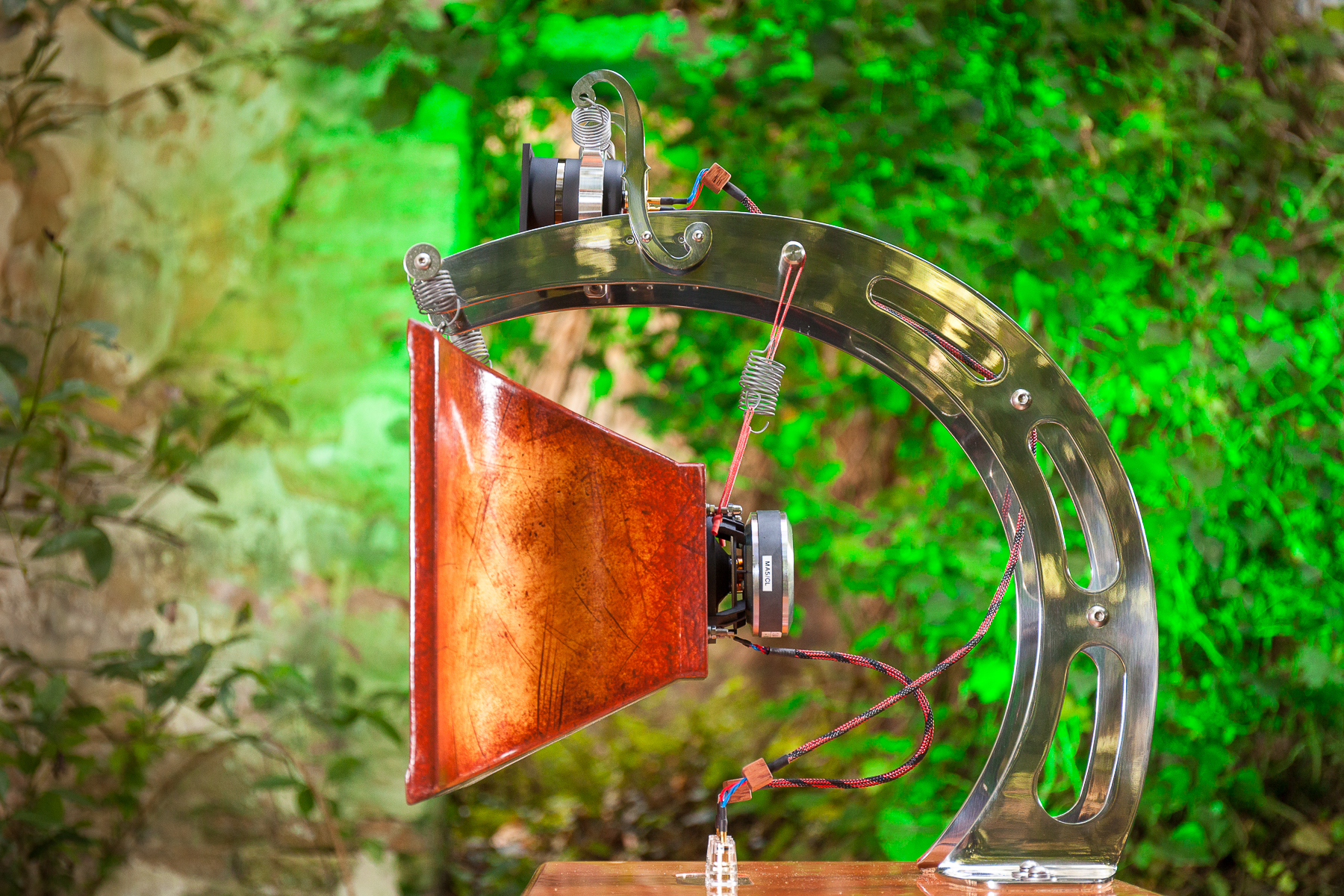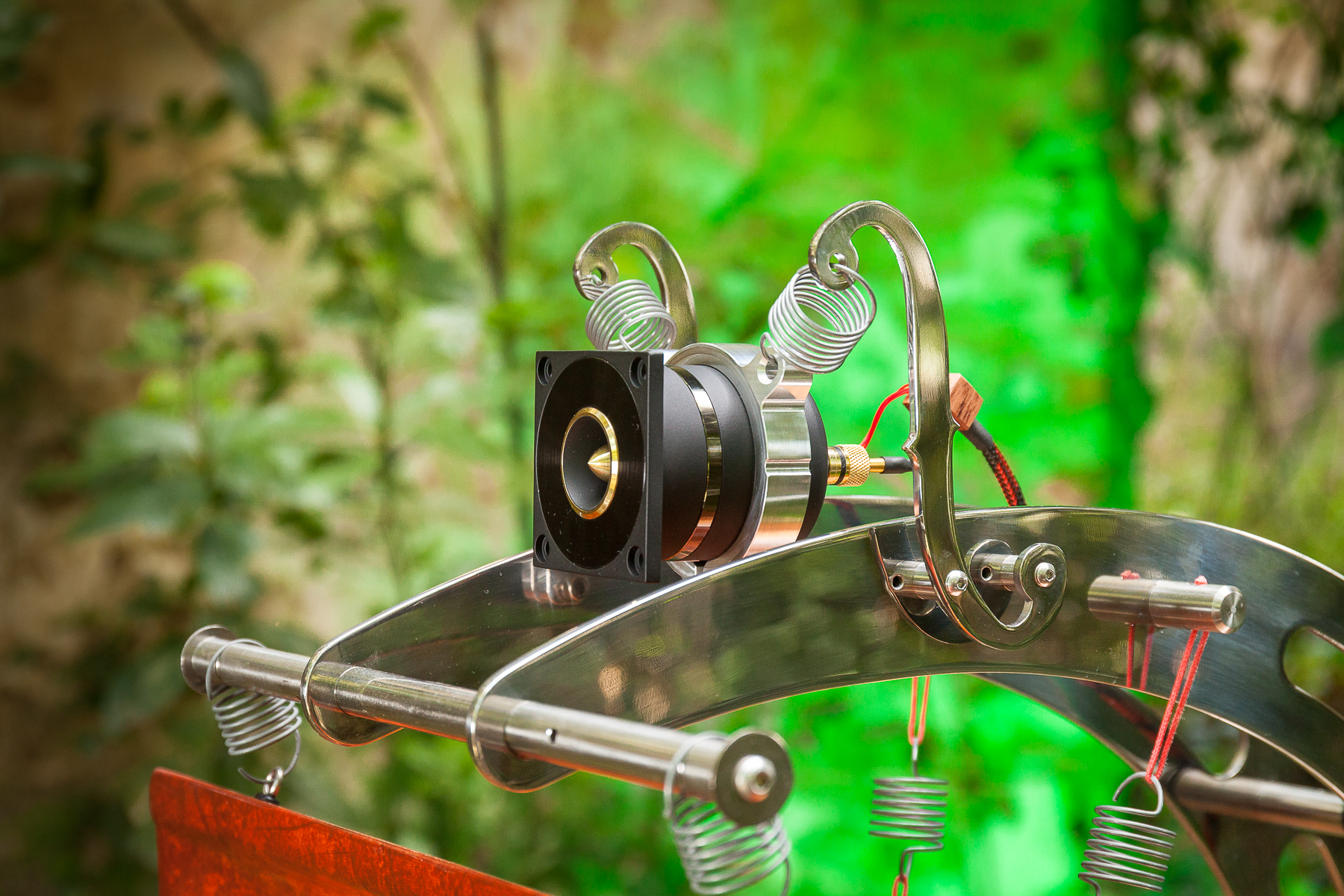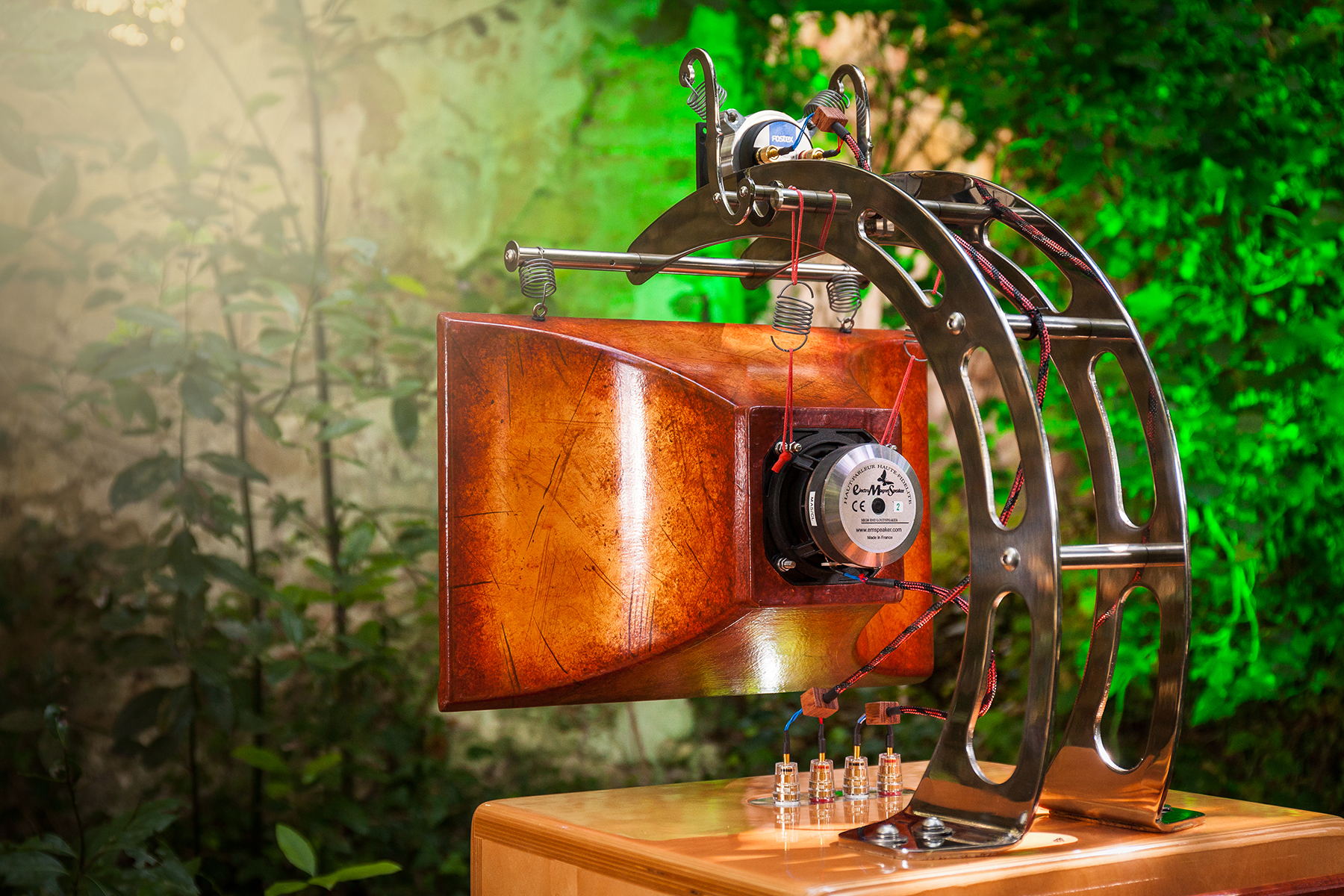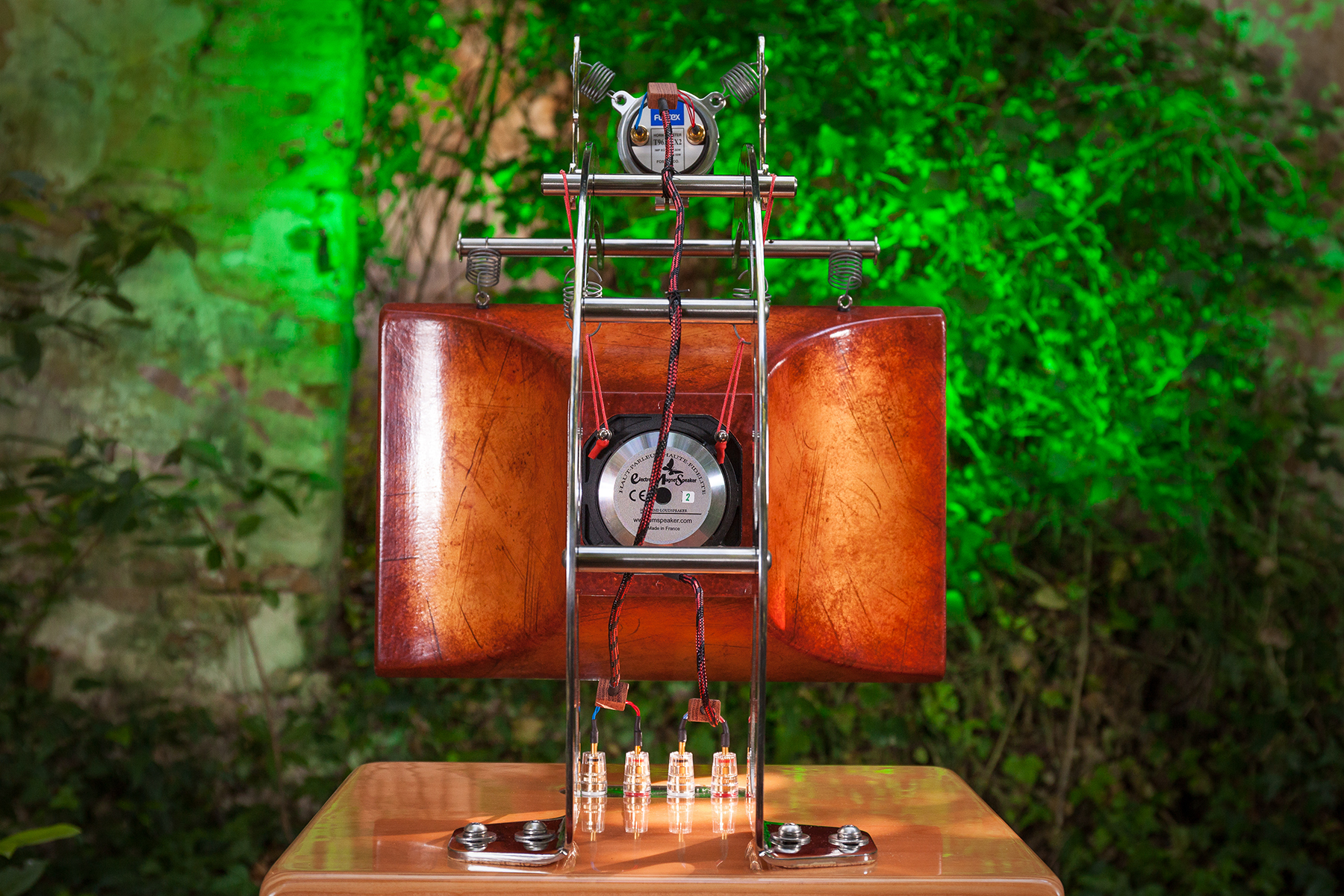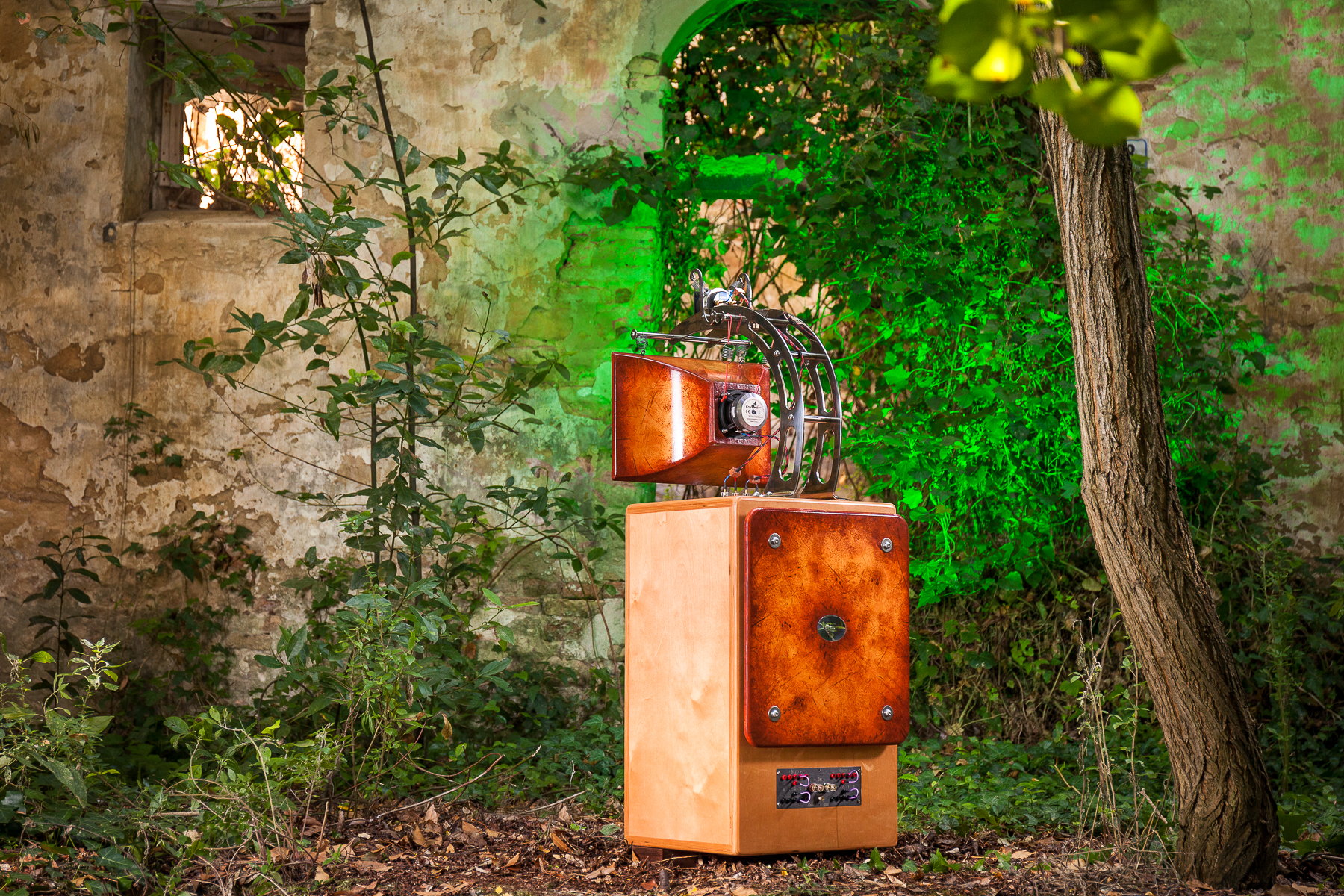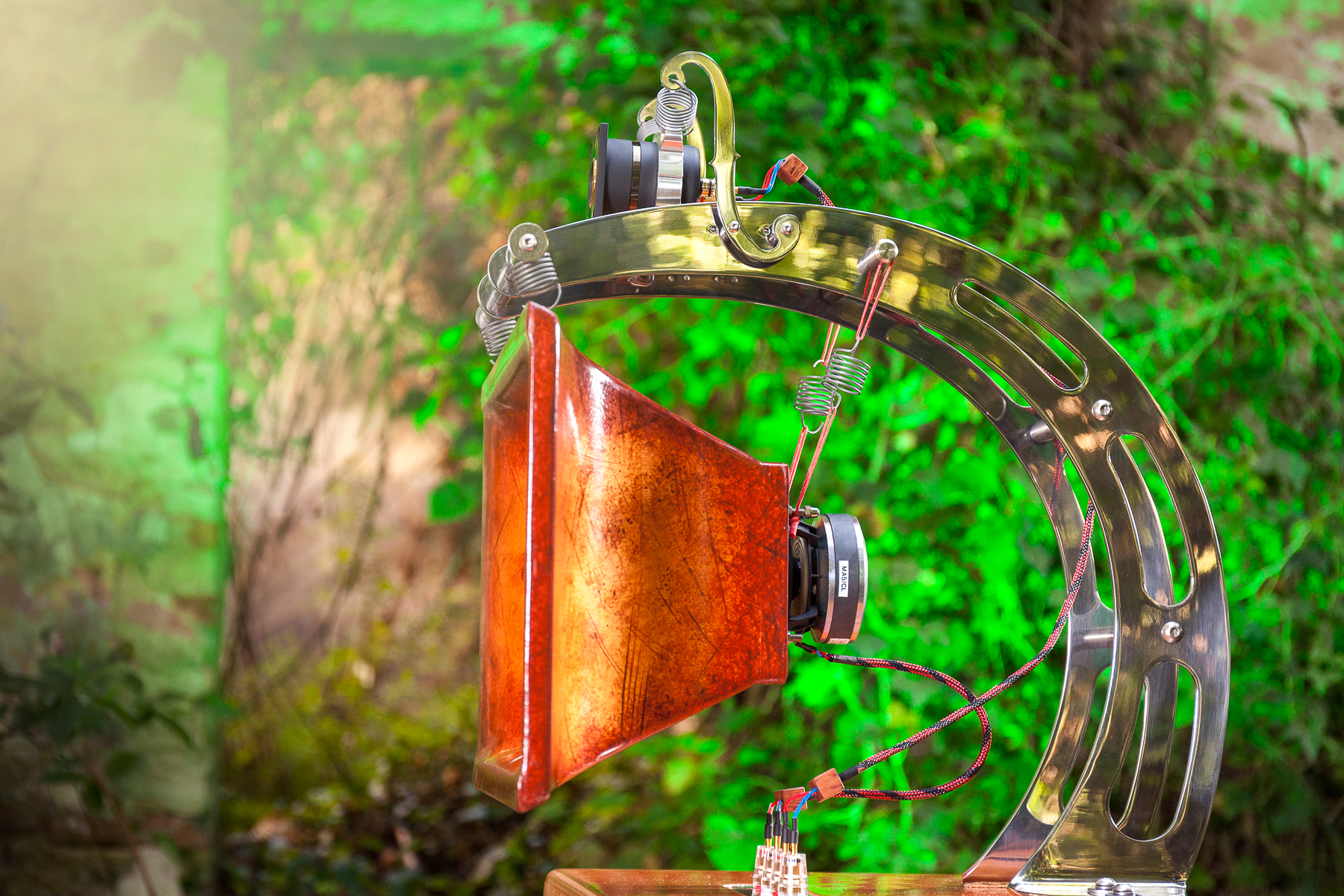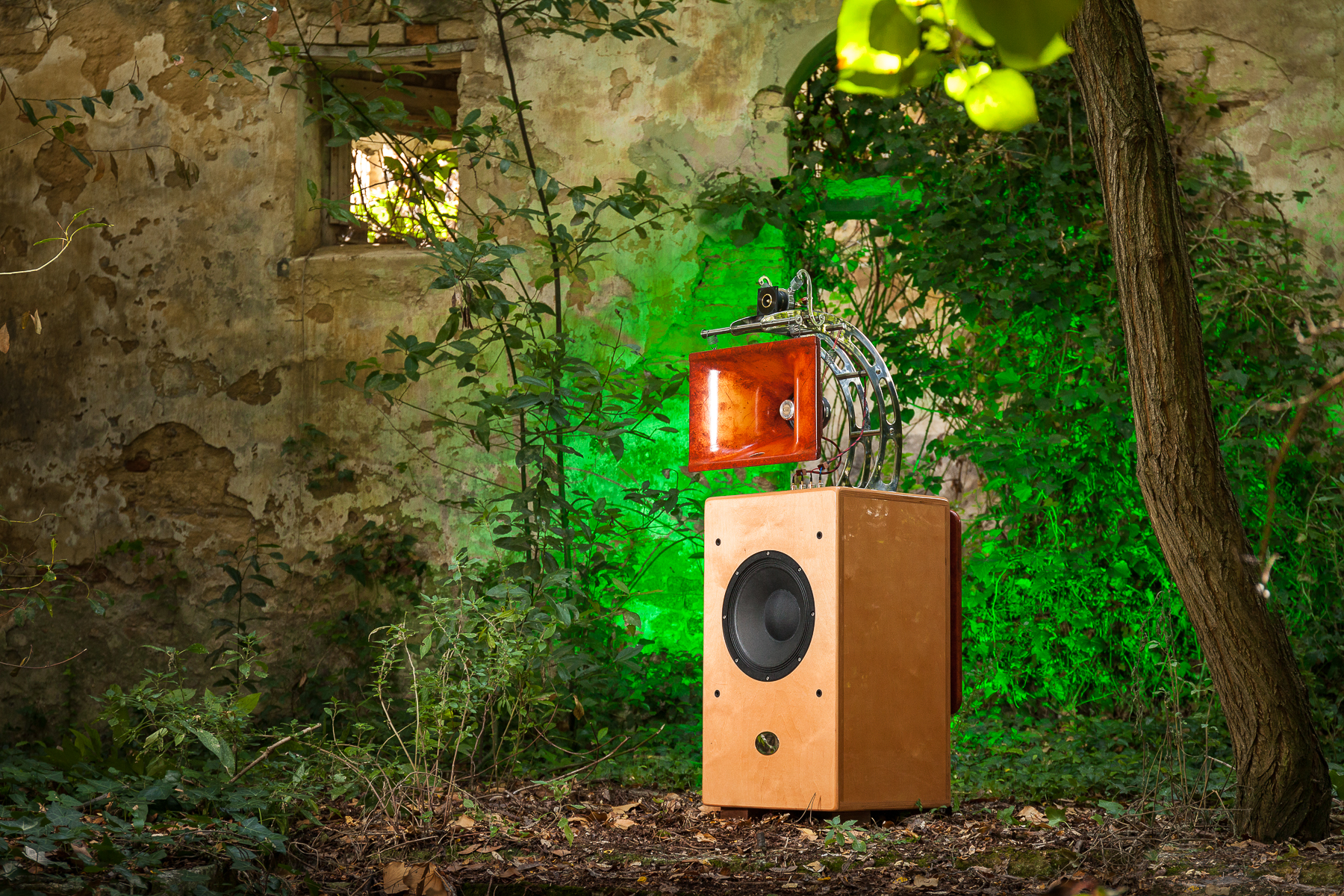Home |
Clinamen | Philosophy | Customer reviews | White paper | Pricing policy | Contact

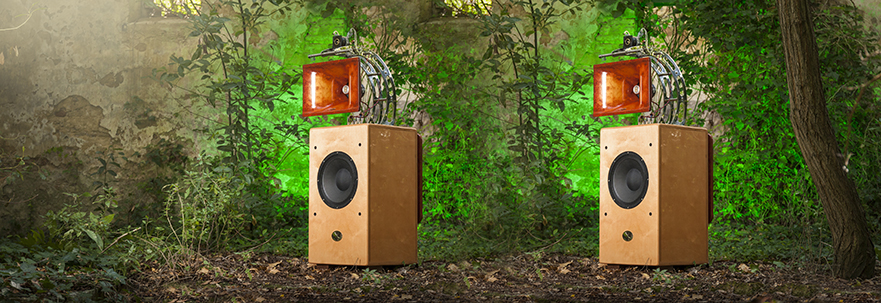
Calabi Yau EVO ( 12" - three way floorstanding)
In the current serial number 4, based on the first three models produced, we have introduced a substantial amount of aesthetic but most of all functional improvements. These changes bring the Calabi-Yau to the top of the range with a reasonable price increase aimed at covering the costs of materials and work processes introduced. Let’s see in detail all the alterations made to the Calabi Yau mk2 compared to the previous version mk1.
-
The volume of the speaker has been increased by about 10 liters for a lower natural resonance frequency Fb and a consequently wider extension in the low register. In return the result is that the speaker (especially if we use our uncoupled spring feet) doesn’t need a stand which saves us some money too.
-
The arms that support the horns and the tweeter are now made of 5mm mirror polished stainless steel in the shape of a golden spiral.
-
The back tuning ports can be set with the spacers supplied, allowing for the possibility of three tuning frequencies. We have dropped the solution of the panel sliding continuously on three captive nuts for better rigidity and neatness.
-
The cabinet, made from 24mm birch plywood, is fully jointed for more structural rigidity and thus better sound.
- There are also component improvements in the crossover. They were very good in the mk1, but now they are outstanding. Indeed we saw the high potential of the CY project and we decided to exalt it.
- That is why we mounted a low pass air core coil of excellent quality on the woofer, a JANTZEN copper foil insulated by paper and impregnated with wax, with a diameter equal to the conductor of 12 AWG. The result is a very low series resistance and acoustically we have a better fast and sensitivity of the woofer. The outstanding CLARITY CAP ESA condensers used in the Calabi Yau mk1 have been replaced by the ALLUMEN Z-CAP by JANTZEN. Rather than being metalized like the Clarity Cap, they have a proper metal foil. They are used in the crossover section of the midrange and tweeter crossover. Their quality is extraordinary; unfortunately their price is equally high
- The phase plugs of the midrange are now made from a billet of Ergal 7075 and no longer from a plastic polymer from made by rapid prototyping, they also carry our logo on the front.
- All the labels and logos on the speaker are now made from mirror polished stainless steel and they are laser marked and not ABS like before.
-
The tweeter has a new supporting bracket made with CNC machine from a billet of Ergal 7075.
-
Woofer and box are coupled via a custom gasket of our own production, laser cut in special paper. It is very important to achieve the appropriate vibrational coupling with the woofer cabinet and thus its final acoustic performance.
-
Another important issue is the tweeter. Unfortunately FOSTEX stopped production of the FT96H tweeter which we used to use satisfactorily. This tweeter was excellent, much better than the more expensive T90A (not linear enough and too efficient, with the need to attenuate it). It has been quite a task to find a replacement. But Fostex itself helped us by making available again in its production an exceptional tweeter that used to be made in limited run: the T96A-EX2.
This tweeter is produced in Japan and has a sensitivity of only 1dB greater than the FT96H; it has brass horn and phase plug (!), a bigger improved magnet (the same of the T90A), a tungsten plate in contact with the edge of the mobile reel used as a damper, copper plated polar expansion, silver plated copper internal wiring. In view of all these wonders, the sale price is much higher than the FT96H. Sonically this tweeter is much superior to the FT96H, in the grain, the elegance, the scenic reconstruction and ambience it can recreate.
OLD SERIES
Calabi-Yau 2 way (SN1)
Calabi Yau mk1 (sn2)
Calabi Yau mk1 (sn3)
Calabi-Yau mk1 wave guide detail (sn3)
CALABI-YAU MK2 DESCRIPTION
The Calabi-Yau Clinamen speaker represents our top of the range loudspeaker.
We believe that loudspeakers are the most important part of the art of reproduction; it is the linchpin around which the rest of the audio chain must be synergically built.
The approach that makes us different is to produce speakers with high electro-acoustic transduction sensitivity. We think this is the only way to get closer to the emotion and realism of a live musical event.
In every field of physics a good project is characterized by high transduction performance. Why shouldn’t be the same in the audio field? In a loudspeaker the input quantity is electrical power, whereas the output quantity is acoustic power. The speaker transforms these two types of energy; the efficiency in carrying out this transduction is called transduction efficiency. In commercial speakers the transduction efficiency is always much lower than 1%!! This means that over 99% of the incoming electrical power is wasted (by entropy, heat, friction, etc.).
You might argue that by supplying a lot of Watts in a low performance speaker we still obtain high acoustic pressure and it is true ( this is the direction taken with the arrival of transistors after the sixties, which made many Watts available at a low cost); but we will never be able to give back the emotion, the harmonic weaving and the vitality of a live musical event. How can we even think that less than 1% of the initial energy is statistically representative of the original electrical signal??
In the professional field, with horns we can reach performances close to 50% (the horns are an impedance transformer and can match the low acoustic impedance of the speaker with the air one) but the issues with this approach are very complex and not easily solvable ( bulkiness, low extension of the low register, hues, non-linearity, directionality of higher frequencies).
Clinamenaudio, after years of tests and listening sessions, reached the solution of the wave guides to load the mid ways. We think it’s the best compromise between efficiency, directivity, distortion and naturalness. For the low register our choice always falls on the direct radiation woofer of at least 12” diameter. We don’t think the horn loading of the low range is advantageous in a home setting; the just about sufficient response doesn’t justify its bulkiness.
Calabi Yau has been created with all the above considerations in mind. It has been designed as an ‘assisted’ full range loudspeaker. This means that most of the audio range is covered by the drivers of the mid-range loaded in the wave guide. The octaves below 500 Hz are referred to a 12” woofer, whilst the extreme pitch above 8 KHz is covered by a compression drive with AlNiCo magnet. Thus the critical vocal range is not segmented and the crossing of the speakers, canceled by the vocal range, are inaudible; this gives a reproduction of great realism and consistency.
Calabi-Yau has a 12” diameter direct radiation woofer; it is unthinkable to have a reasonable musical impact and low distortion with a woofer of 16cm diameter and excursion of 2cm and beyond. The low range supplied by them is entirely based on the resonance of the air inside the box; the frequencies reproduced are monotonous without any articulation and vivacity. Furthermore the distortion is very high due to the Doppler effect. A woofer with big diameter has a much higher acoustic impedance of radiation and it can supply much more realistic dynamics and impact.
The woofer is inspired by the professional components of the past; it has a paper membrane and canvas suspension. The extremely light membrane associated with the high force factor (Bxl) of 17 Tesla per meter allows rapid accelerations of the mobile equipment. The sufficiently rigid suspension brings the mobile equipment in its resting position quickly. The basket is made of die cast aluminum and it could not be otherwise, given the weight of the 200mm diameter magnet.
Calabi-Yau has a low frequency electrical crossing, only 500 Hz with low electrical slope. The natural slopes of the speakers used are exploited. The crossover helps rather than imposing its work.
On the high range we find a 5” full range speaker with a very powerful acceleration factor and paper membrane, weighing only 3 grams, which works in a wave guide with a mouth sides in golden ratio. On its central pole an acoustic phase plug made from a CNC machined of billet of Ergal 7075 is lap jointed, which optimizes the response in useful range and works as a mechanic filter for the frequency of 8KHz and above.
Furthermore, thanks to the level controls with transformers on the mid-range, the filtering of the latter towards the low frequencies is supported by the natural roll-off of the magnetic element. Through a thorough calculation of the primary inductance of the transformer, the loudspeaker is elegantly assisted in the filtering process. These are examples of how Clinamenaudio designs by following the Natural Path of Sound, by exploiting to its own advantage parameters which, depending on the condition they are used in, become a value rather than a fault.
In the wave guides the loudspeaker is interfaced to the ‘horn’ with a 1:1 ratio (troath area equal to the membrane area) and this gets rid of any distortion due to the compression of air. Most importantly, the increase of efficiency recorded is perfect to match the sensitivity of the woofer (97db/W/m).
By using traditional compression drivers in Hi-Fi we get all the downsides of a horn loudspeaker (hues, non-linearity, distortions) for the purpose of obtaining a very high efficiency which will then be sacrificed, because it is often too high to match the sensitivity of the low range. The wave guide on the contrary supplies an efficiency increase perfectly matching the woofer’s sensitivity.
All the high range of the ‘Calabi-Yau (mid, horn and tweeter) is mounted hanging from the main box through a 5mm AISI 304 framework reinforced by cross connection rods. The flexible mounting of the wave guide and the tweeter are a ‘low-pass’ coupling with very low Fs. This means that all the vibrations with frequency higher than a few Hz cannot go through the mechanic filtering system and therefore they do not interfere with the correct reproduction of mid and tweeter.
We would like to highlight the elegance of the tweeter support; two ‘f’ shaped brackets which, through springs, support a ring made with CNC working from a billet of Ergal 7075, which is also tied to the tweeter.
The crossover is obviously point to point hand wired on a board made from birch plywood and it uses exclusive and high quality crossover components. The woofer’s coil is made from copper leaf coiled in air, insulated with paper and resinated with natural wax. It has a very low parasite resistance; indeed the leaf has a diameter equal to an AWG 12 cable. The resulting advantages are damping, speed and harmonic richness given back by the woofer. The condensers of the mid-range are made from a parallel of JANTZEN ALLUMEN Z-CAP, of solid aluminum foil (not metalized). On the tweeter we use JANTZEN AMBER Z-CAP made from solid copper foil.
The inner wiring uses Clinamen cables made from silver plated copper insulated with Teflon.
The cabinet is made from birch plywood of 24mm thickness with jointed panels and the internal acoustic absorption material is natural wool.
The woofer is tuned in box with an adjustable back tuning port, which allows to change the tuning frequency of the cabinet from 90 down to 35 Hz. This enables the calibration of the response in low frequency of the speaker depending on the surrounding, the rest of the audio chain and personal taste. The tuning is through a distributed port, with a variable length asymmetrical tube. The quality and articulation of the low range is absolutely unknown to ordinary reflex systems.
The possibility of calibrating the tuning frequency for the customer is a very important element that helps the integration of the loudspeaker in their listening room and adapts to the listener’s taste. Also, the area of the tube, whose surface is similar to the woofer’s membrane, allows to have a very low pressure inside the cabinet; this reduces all the issues of resonances and internal stationary waves. We have never seen such a tuning system in any commercial product; we think this clever solution will be used as an example by other companies. By making it public, we can assure you that we’ve been the first.
On the back panel of the speaker it is possible to calibrate the emission of the mid and acute register: both mid-range and tweeter can be set on 5 levels of emission with a 1 dB step difference. The controls are inductive, designed with magnetic elements. The classic L-PAD or resistive attenuators introduce a heavy dynamic limitation and timbral hue. The levels commutation is implemented by a system of plugs and jacks to guarantee the highest quality of the electrical contact which a rotary switch cannot ensure.
Calabi Yau is sold varnished in a color chosen by the customer or birch plywood color for those who love natural wood. It is available within 4 months of the ordering date.
The Clinamen products are built with craftsmanship and care from design to execution. Each detail is taken care of with passion and true dedication to the musical art. Our commercial policy guarantees that you are buying the highest technical/artistic product, because we don’t have any advertising and distribution costs. Our best advert is the quality we offer and the word-of-mouth of the enthusiasts.
TECHNICAL DATA
- Three way speaker system, with wave guide for low power, high quality 0 feedback triode amplifers.
- Hand made in Italy
- Sensitivity: 97 db/W/m
- Dimension : L=45 cm. H= 122 cm ( feets included). D=52 cm
- 12 inch woofer with underhung voice coil geometry; die cast frame. Very powerful acceleration factor BxL for very fast impulse response
- Proprietary woofer loading system named TDDR (Tuned distribuited damped reflex) . The tuning frquency of the box is variable ,by the customer, in three values, for best matching of the loudspeakers with listening rooms and own tastes.
- 24mm birch plywood cabinet, fully jointed for more structural rigidity and thus better sound
- Mid range way implemented with 5" full range driver EMS CUSTOM CLINAMEN wave guide loading. Dipolar emission.
- The mid range driver and wave guide is hanging with spring system.
- Tweeter Fostex T96A-EX2 made by Fostex JAPAN , with bronze horn and phase plug. the tweeter is hanging with springs system and CNC bracket
- Wood wave guide with a mouth sides in golden ratio
- CNC ERGAL phase plug for mid range driver
- Mid and high way level adjustment with inductive custom components --> -2dB/-1dB/0/+1dB/+2dB
- Very low woofer crossover frequency, only 500 Hz. First order filter for better sound.
- Human frequency band without crossover point ( 500 Hz --> 8 Khz)
- Hand made crossover building on a birch plywood, point to point wired.
- Low pass woofer coil : JANTZEN AWG 12 copper foil insulated by paper and impregnated with wax
- Mid way crossover capacitor: JANTZEN ALLUMEN Z-CAP true Alluminum foil
- High way crossover capacitor: JANTZEN AMBER Z-CAP true copper foil
- acoustic absorption material in the box : natural wool
- Custom Clinamen internal wiring ( silver plated OFC copper, teflon isulator, multiconductor, twisted)
- Ground connection for the woofer frame
- Maximum applicable power : 30Wrms
- Reccomended power amplifier : 4 Watt-->15 Watt ( Vaccum tubes, class A, zero feedback)
- All stainless steel screws
- Available finishes : painted wood ( mat or glossy), lacquering (mat, glossy, metalizzed , pearled)
PRICE AND ACCESSORY
- Price with mat lacquering painted :16600 euro
- Extra charge for glossy lacquering: 300 euro
- Extra charge for metallized lacquering: 400 euro
- Extra charge for pearled lacquering: 600 euro
- Decoupling spring feets ( HH) are strongly reccomended
GENESI OF THE NAME
The name Calabi Yau is a tribute to Eugenio Calabi and Shing-Tung Yau, two mathematicians (the former is Italian) who studied and formalized the 6 dimension mathematical spaces of Calabi-Yau. The ‘practical’ application of these spaces is the string theory. It is at present a theory being studied and not yet experimentally verified, which states that the inner most and smallest components of the matter are made of tiny vibrating strings.
betulla ramata / rame ossidato (sn4)


